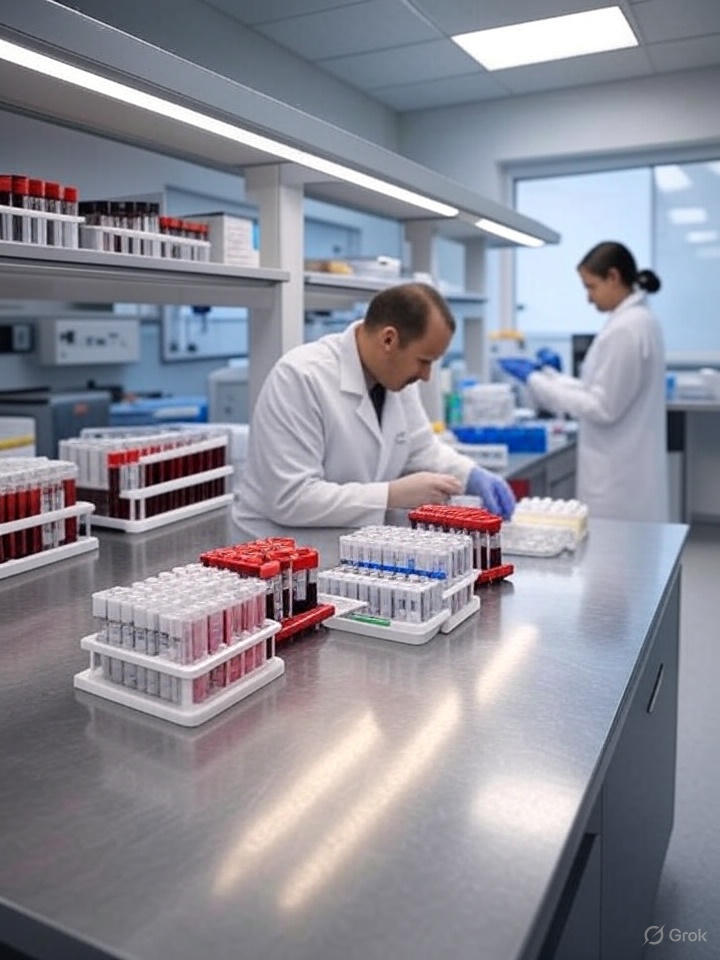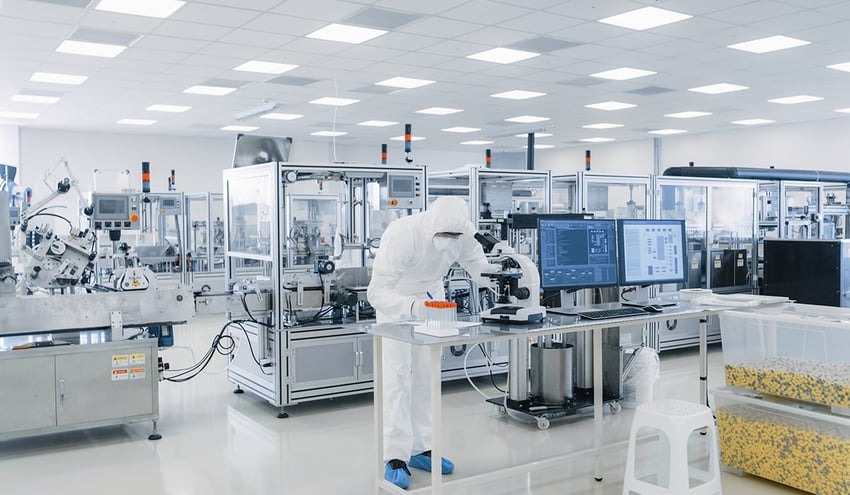The Ultimate Guide for Professionals, Researchers, and Entrepreneurs
Introduction
A blood bank laboratory is a critical pillar of modern healthcare, research, and industrial safety. For professionals, researchers, and business owners, establishing a blood bank lab is a strategic investment that requires meticulous planning, regulatory compliance, and a deep understanding of technology and market needs. This comprehensive guide covers every aspect of setting up a blood bank lab—whether for medical, research, industrial, or educational purposes. Throughout, you’ll find friendly keywords such as blood bank lab setup, blood bank equipment, blood bank business plan, and laboratory accreditation to enhance search visibility.

What is a Blood Bank Lab?
A blood bank laboratory is a specialized facility where blood is collected, tested, processed, stored, and distributed for transfusion or research. These labs are essential in hospitals, research institutes, pharmaceutical companies, industrial safety programs, and educational institutions. The primary mission is to ensure a safe, reliable supply of blood and blood components for patients and research.
Key Functions of a Blood Bank Laboratory
- Blood Collection: Gathering whole blood from voluntary or replacement donors.
- Component Preparation: Separating blood into components (red cells, plasma, platelets).
- Testing: Screening for infectious diseases, blood grouping, and compatibility.
- Storage: Maintaining optimal conditions for blood and components.
- Distribution: Supplying blood to hospitals, clinics, and research centers.
- Quality Control: Ensuring safety, traceability, and regulatory compliance.
- Education & Training: Providing hands-on experience for students and professionals.
Planning Your Blood Bank Lab
1. Define Your Lab’s Purpose
- Medical/Clinical: Focus on transfusion services, patient care, and emergency preparedness.
- Research: Support studies in transfusion medicine, immunohematology, and epidemiology.
- Industrial/Quality Control: Ensure workplace safety and compliance in high-risk sectors.
- Educational: Facilitate training in blood banking techniques and laboratory safety.
2. Market Analysis and Business Plan
- Target Market: Hospitals, clinics, research organizations, public health agencies, industry partners, and educational institutions.
- Competitive Analysis: Assess local and regional competitors, their services, and pricing.
- Regulatory Landscape: Understand licensing, accreditation, and compliance requirements (e.g., NABL, CAP, CLIA, ISO 15189)1.
- Financial Projections: Estimate startup costs, operational expenses, and revenue streams.
- Business Model: Define your service offerings, pricing strategy, and value proposition.
3. Facility and Infrastructure
- Location: Choose a site with easy access for donors, clients, and sample logistics. Avoid proximity to unhygienic surroundings such as open drains or animal houses2.
- Space Planning: Allocate areas for donor reception, blood collection, processing, testing, storage, and waste disposal. Minimum area requirements are typically 100–150 sq. meters, with additional space for component preparation and apheresis.
- Utilities: Ensure reliable water supply, drainage, electricity (with backup), and ventilation.
- Sanitation: Use materials for floors, walls, and ceilings that are smooth, impervious, and easy to clean.
- Security: Restrict access to authorized personnel; provide secure storage for blood and reagents.
Essential Equipment and Instruments
A well-equipped blood bank lab should have the following core instruments:
| Equipment | Purpose/Function |
|---|---|
| Blood Collection Monitor/Scale | Monitors and measures blood volume during collection |
| Blood Bank Refrigerator | Stores whole blood and components at 2–6°C |
| Plasma Freezer | Stores plasma at –30°C or lower |
| Platelet Incubator & Agitator | Maintains platelets at 20–24°C with continuous agitation |
| Refrigerated Centrifuge | Separates blood components by density |
| Blood Bag Tube Sealer | Seals blood bag tubing safely |
| Plasma Thawing Bath | Thaws frozen plasma for transfusion |
| Laminar Air Flow Hood | Provides aseptic workspace for component preparation |
| Deep Freezer/Ultra-Low Freezer | Stores rare blood or research samples at –80°C |
| Elisa Reader/Plate Analyzer | Screens for infectious markers |
| Water Bath | Maintains constant temperature for reactions |
| Analytical Balance | Precise weighing of samples and reagents |
| Microscopes | Visualizes cells and contaminants |
| Autoclave | Sterilizes equipment and media |
| Computer & Data Logger | Data management and temperature monitoring |
| Donor Couch/Chair | Comfortable seating for blood donors |
| Personal Protective Equipment (PPE) | Ensures staff safety |
This list should be tailored to your lab’s specific focus (clinical, research, industrial, or educational.
Blood Bank Lab Layout and Workflow
Layout Considerations
- Donor Reception & Waiting Area: For registration and pre-donation counseling.
- Blood Collection Room: Dedicated space for drawing blood with privacy and comfort.
- Component Preparation Room: For centrifugation, separation, and labeling.
- Testing Laboratory: For serology, infectious marker screening, and cross-matching.
- Storage Area: Refrigerators and freezers for blood and components.
- Waste Management Room: For safe disposal of biohazardous and chemical waste.
- Administrative Office: For documentation, billing, and communication.
Workflow Optimization
- Unidirectional Flow: Ensure samples and donors move in one direction to minimize cross-contamination.
- Zoning: Separate clean and contaminated areas.
- Automation: Implement Laboratory Information Management Systems (LIMS) for tracking and reporting.
- Ventilation: Mechanical ventilation with inward airflow; avoid recirculation to public spaces
Staffing and Training
Key Personnel
- Lab Director/Manager: Oversees operations, compliance, and quality assurance.
- Medical Officers/Transfusion Medicine Specialists: Supervise donor selection, testing, and transfusion.
- Medical Laboratory Technologists: Perform routine and specialized analyses.
- Technical Assistants: Support sample processing and equipment maintenance.
- Donor Counselors: Guide and support donors through the process.
- Administrative Staff: Handle billing, logistics, and customer service.
Training and Competency
- Initial Training: On SOPs, equipment use, and safety protocols.
- Ongoing Education: Updates on new technologies, quality standards, and regulatory changes.
- Competency Assessment: Regular evaluation to ensure proficiency and compliance
Safety and Quality Assurance
Safety Measures
- Personal Protective Equipment (PPE): Lab coats, gloves, masks, and eye protection.
- Biosafety Cabinets: For handling infectious materials.
- Hand Hygiene: Dedicated handwashing stations within 25 feet of all work areas.
- Chemical Safety: Proper storage, labeling, and handling of reagents.
- Fire Safety: Extinguishers, alarms, and emergency exits.
- Waste Disposal: Segregation and safe disposal of biological and chemical waste.
- Universal Precautions: Treat all specimens as potentially infectious.
- Decontamination: Clean work areas before and after use with appropriate disinfectants.
- Emergency Procedures: Eyewash stations, spill kits, and clear protocols for exposures.
Quality Control
- Internal QC: Regular calibration of instruments, use of control samples.
- External QC: Participation in proficiency testing programs.
- Documentation: Maintain detailed records of procedures, results, and incidents.
- Accreditation: Seek certification from recognized bodies (e.g., NABL, CAP, ISO 15189).
Common Blood Bank Lab Services
| Service Type | Description | Clinical/Research Relevance |
|---|---|---|
| Blood Collection | Whole blood, apheresis, and component donations | Transfusion, research, emergencies |
| Component Preparation | Red cells, plasma, platelets, cryoprecipitate | Tailored therapy, research |
| Infectious Marker Testing | HIV, HBV, HCV, Syphilis, Malaria, etc. | Ensures transfusion safety |
| Blood Grouping & Cross-Matching | ABO, Rh typing, compatibility testing | Prevents transfusion reactions |
| Antibody Screening | Detects irregular antibodies | Safe transfusions, prenatal care |
| Storage & Inventory Management | Monitors stock and expiry | Reduces wastage, ensures availability |
| Distribution | Supplies blood to hospitals and clinics | Critical for patient care |
| Research Support | Provides samples for studies and trials | Advances medical knowledge |
Regulatory Compliance and Accreditation
- Licensing: Obtain necessary licenses from local and national authorities (e.g., State Drug Controller, NABL in India, CLIA, FDA).
- Accreditation: Demonstrates adherence to international quality standards (ISO 15189, CAP).
- Quality Management System: Implement SOPs, equipment logs, and personnel records.
- Audit Readiness: Regular internal and external audits to ensure compliance.
- Data Security: Ensure donor and patient data are securely stored and privacy is maintained.
Budgeting and Financial Planning
Startup Costs
- Infrastructure: Renovation, utilities, and security.
- Equipment: Purchase, installation, and calibration.
- Consumables: Blood bags, reagents, PPE, and disposables.
- Staffing: Salaries, training, and benefits.
- Licensing and Accreditation: Application fees and inspection costs.
Operational Expenses
- Reagent and Consumable Replenishment
- Equipment Maintenance and Service Contracts
- Utilities (Electricity, Water, Internet)
- Waste Disposal Services
- Insurance (Liability, Fire, Theft)
Revenue Streams
- Blood and Component Supply Services
- Research Contracts and Grants
- Training and Educational Programs
- Consulting and Quality Assurance Services
Develop a detailed business plan with financial projections to attract investors and manage growth.
Marketing and Growth Strategies
- Digital Marketing:optimized website, social media, and online advertising.
- Partnerships: Collaborate with hospitals, clinics, and research organizations.
- Quality Differentiation: Emphasize accreditation, turnaround time, and advanced technology.
- Donor Engagement: Organize blood drives, provide donor incentives, and maintain communication.
- Customer Service: Reliable reporting, transparent billing, and responsive support.
- Continuous Improvement: Invest in staff training, equipment upgrades, and new service offerings.
Trends and Innovations in Blood Banking
- Automation and Robotics: Increase throughput, reduce errors, and improve reproducibility.
- Digital Inventory Management: Real-time tracking of blood units and expiration dates.
- Pathogen Reduction Technologies: Enhance safety of blood components.
- Mobile Blood Collection Units: Expand reach and donor base.
- Artificial Intelligence: Predict demand, optimize inventory, and improve donor recruitment.
- Sustainable Practices: Energy-efficient equipment and waste reduction.
Checklist for Setting Up a Blood Bank Lab
- Define lab purpose and scope
- Conduct market and competitor analysis
- Prepare a detailed business plan
- Secure funding and location
- Design lab layout and workflow
- Procure essential equipment and consumables
- Recruit and train qualified staff
- Implement safety and quality protocols
- Obtain necessary licenses and accreditations
- Launch marketing and outreach initiatives
Conclusion
Establishing a blood bank laboratory is a complex but rewarding endeavor that blends science, business, and regulatory compliance. By following best practices in planning, infrastructure, equipment selection, staffing, safety, and quality assurance, you can build a lab that meets the needs of healthcare, research, industry, or education. Stay updated with technological advancements and regulatory changes to ensure your lab remains competitive and compliant.
Keywords Used
- blood bank lab setup
- blood bank equipment
- blood bank business plan
- laboratory accreditation
- laboratory safety protocols
- blood bank tests
- laboratory workflow
- laboratory quality control
- clinical diagnostics
- research laboratory
- laboratory automation
- laboratory compliance
- laboratory marketing strategies



